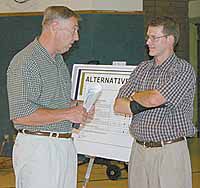| Local juvenile detention center director Randy Railsback talks with a Lockner engineer about the alternatives being considered for SR-10 at a meeting on Tuesday. The engineers and UDOT officials met with residents to discuss options and will return to the area with additional information after finishing the analysis on the comments raised during the Aug. 17 public meeting. |
Transportation department contract engineers discussed the public comments about Utah State Road 10 accepted during a June meeting with local residents on Aug. 17 at the Carbon County School District offices.
“We have tried to group the ideas you brought us into different areas,” said H. G. Kunzler, a project engineer with H.W. Lockner Inc. “We wanted to show you how each of the alternatives we have come up with relate to the SR-10 corridor.”
The engineers and Utah Department of Transportation officials developed charts and graphs showing travel routes, traffic flow percentages and alternatives to remedy some of the problems on SR-10 identified by people in June.
The public concerns included general safety issues, the absence of left-turn lanes on the section of SR-10 from Stake Farm Road to U.S. Highway 6, the narrow roadway and shoulders, coal-hauling and industrial truck traffic, inadequate access for motorists entering and exiting the highway, the lack of sidewalks and the possible relocation of the existing corridor.
The transportation department had identified several possible alternatives for dealing with the problems in question and the options were presented to the audience in a short program.
The alternatives included the following possibilities:
•Leaving the stretch of highway from Stake Farm Road to U.S. 6 unchanged.
•Constructing a west bypass road to handle the SR-10 traffic.
The option would involve having the new bypass highway tie into U.S. 6 west of the existing intersection.
On the south end, the new highway would tie into SR-10 near the Ridge Road intersection.
The present road would be used for local access and no improvements would be undertaken on the highway.
•Constructing an east bypass road.
The bypass highway would attach to U.S. 6 east of the present junction and connect with SR-10 near Ridge Road.
The existing road would be used for local access and no improvements would be done.
•Widening the section of SR-10 to a four-five lane or a four-three lane configuration.
Turning lanes would be the key in many places to alleviate safety problems
•Building a truck traffic only bypass road.
Only trucks and heavy vehicle traffic would be allowed.
The bypass would tie in at Ridge Road and connect with U.S. 6 east or west of the present corridor.
•Building a railroad line to reduce the truck traffic on SR-10, from the coal loadout to Huntington.
•Applying transportation system and/or travel demand management principles.
The option would increase the capacity of the corridor without changing the road by using park and rides, carpooling, flexible work hours, tele-commuting and truck restrictions.
•Developing plans for a local public transit system.
The concept involves reducing vehicle counts on SR-10 by transporting people on buses.
The engineers pointed out Aug. 17 that not all of the alternatives will solve a significant number of the concerns voiced by Carbon County residents, especially in the long term.
“We took a baseline of growth from 1988 to the present and it showed if that growth continues to the year 2030 there will be 30,000 vehicles a day using that road,” said Kunzler. “We want to look at alternatives that will serve the corridor about 30 years and if that projection is the case, then some of these alternatives will not suffice.”
One of the residents attending the meeting on Tuesday wondered if it was possible for the highway to grow that much more, even though the trend had remained true in the past.
“The point is that driving habits are changing and we can only go on the baseline we have had for growth in the past,” said Myron Lee, a UDOT spokesman at the Aug. 17 meeting. “People have changed the reasons they drive somewhere in the past, and that may be the reason for the growth. Those trends could well continue.”
One chart displayed at the meeting by UDOT officials highlighted the traffic flow percentage for SR-10. Based on studies, the chart showed that about 26 percent of the traffic on SR-10 comes or travels west on U.S. 6 from the highway and another 13 percent goes or comes from the east.
“Traveling both ways, that means 61 percent of the traffic flows through either into Price or back toward Emery County,” explained Kunzler.
Similar numbers figure heavily in which alternatives to consider as a possible project. The percentage flow may mean east or west bypass roads would not be an effective alternative in the long run because more than 60 percent of the drivers who want to go to or come from Price would still take the old route rather than the new one, pointed out Kunzler.
After reviewing the alternatives, Kunzler asked for the audience to look at the charts and fill out comment forms on the various plans.
Kunzler pointed out that the final chart showed that some of the options would work better than others, but the engineers wanted to hear from local residents who might have suggestions regarding the alternatives developed for SR-10.
“We are just trying to whittle down the alternatives and spend as little money as possible developing those that are not effective,” said Kunzler. “Within a month or so, we will be coming back to you again to go over what we have come up with for the most viable plans.”

